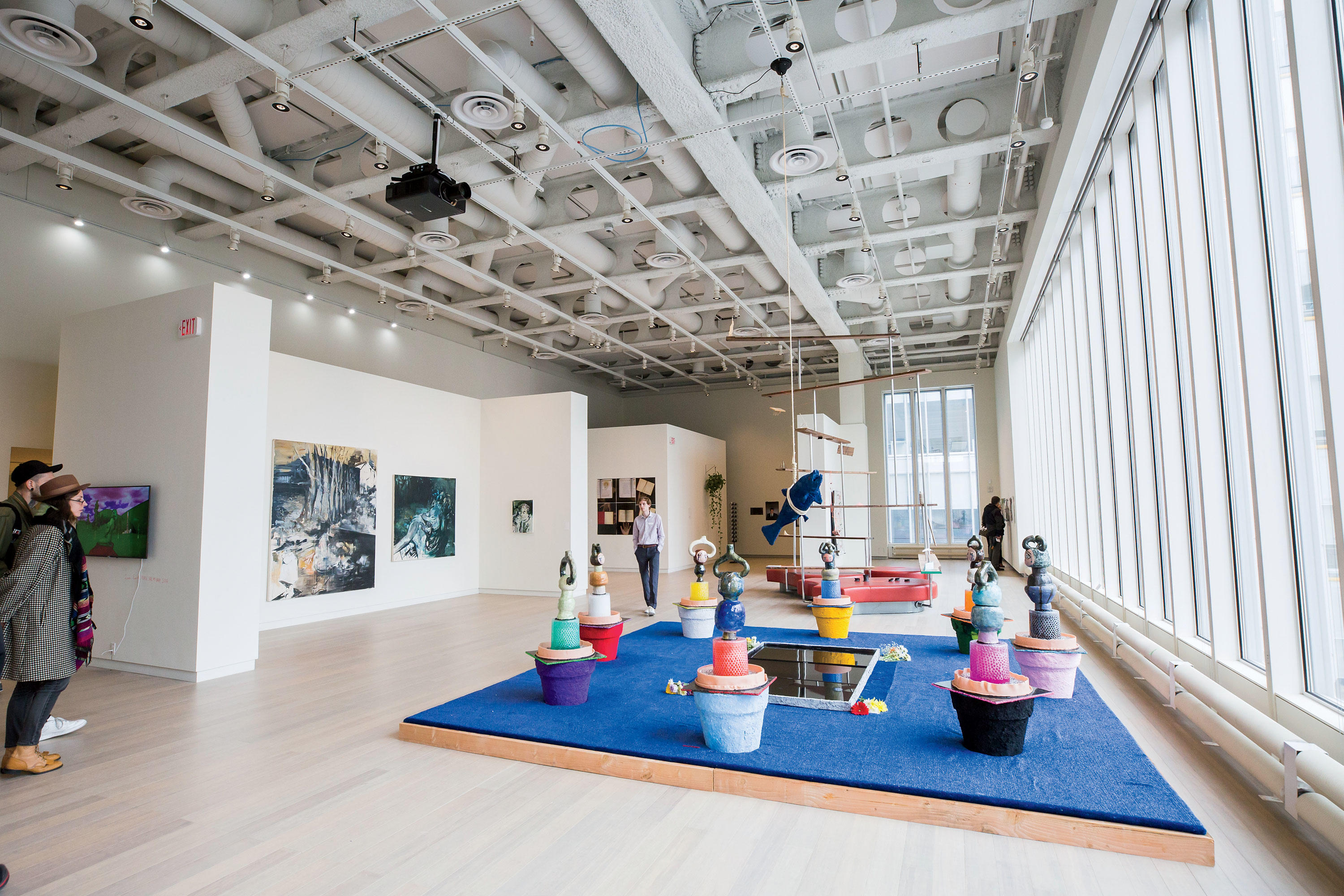First, there are the elevators. Like visual sorbet, their intense orange walls seem to cleanse the optical palate, so that when the doors open onto the sixth floor of the Lenfest Center for the Arts and visitors step into the Miriam and Ira D. Wallach Art Gallery, their eyes are already primed to soak up the paintings, sculptures, and installations within. And yet the initial sensation of entering the 3,600-square-foot sunlit space is visceral as well as visual: a jolt of recognition that one is standing in an important new art venue in New York, and therefore the world.
Which is just what Deborah Cullen had hoped for. Five years ago, when Cullen was appointed director and chief curator of the Wallach Art Gallery, she was tasked with moving the institution from its 2,300-square-foot windowless warren on the eighth floor of Schermerhorn Hall to a bigger, more accessible space in a brand-new location on West 125th Street in Manhattanville.
A self-described “art-history nerd,” Cullen, who spent fifteen years as the curator of El Museo del Barrio, had long been an admirer of the Wallach. Established in 1986 by Columbia’s Department of Art History and Archaeology, and known for its research-based programming, the gallery was a hidden jewel that deserved a more prominent setting.
For Cullen, overseeing this move was a dream assignment. The things she would be able to do — the spatial puzzles to solve, the boundaries to push! Here, too, was a chance to infuse the Wallach with the fresh blood of living artists — including those from surrounding communities and the School of the Arts — and offer that vibrant bouquet to the public.
On April 22, when the Lenfest Center opened, Cullen welcomed visitors to the Wallach’s inaugural show: the annual MFA thesis exhibition for the School of the Arts’ visual-arts program. It was the first time that this showcase had been held on campus. (Schermerhorn was too small, so for years it was held at a space in Long Island City.) Throughout the day, hundreds of people poured across the public plaza, entered the building, and passed through the glass-enclosed lobby and into those orange elevators.
Inside the Wallach, the artwork hung, dangled, spread, rose from the wood floor, beckoned from around corners. People stared, cocked their heads, or stood with hands clasped in pensive attitudes. Some took pictures with their phones. And there was Deborah Cullen, chatting with artists and faculty and guests and photographers. She looked thoroughly excited and slightly overstimulated. “I feel like an anxious mother,” she said with a laugh.
Cullen had mastered the boxlike space by shrewdly breaking it up with thick movable walls, creating a graceful layout with ample room for each student’s work. “I try to give it some flow and sensibility,” Cullen says. “It’s sort of like figuring out a Rubik’s Cube.”
The Wallach will be open year-round, and Cullen wants the public, and especially the neighbors, to know that this is their gallery, too. “This seems like a wonderful time to be thinking about broader community,” Cullen says. “We need to let people know they’re welcome: Here we are. It’s free. We want you here.”
Community-building is part of the impetus behind the Wallach’s next show, Uptown, which runs from June 2 to August 20. The exhibit features artists who live or work north of 99th Street. “I think it’s really important for Columbia to be a good neighbor and put its money where its mouth is,” says Cullen. “There’s not a lot of overlap or cross-pollination between the neighborhoods of northern Manhattan.” Uptown brings together artists from Harlem, Washington Heights, El Barrio, and elsewhere.
In assembling the artists, Cullen drew from her own knowledge and solicited more names from other local institutions: the Studio Museum in Harlem, the Hispanic Society of America, and the Schomburg Center for Research in Black Culture. And as she met new artists, she asked them for recommendations. “Pretty soon I had a list of two hundred artists,” says Cullen. She selected about twenty-five for Uptown.
Winnowing things down on the one hand, expanding them on the other: Cullen the scene-shifter, the space-shaper.
The space-sharer.
“People have been wandering into the lobby of Lenfest and saying, ‘What is this?’” says Cullen. “That’s a real benefit. We didn’t have drive-by traffic in Schermerhorn. But here we will.”



